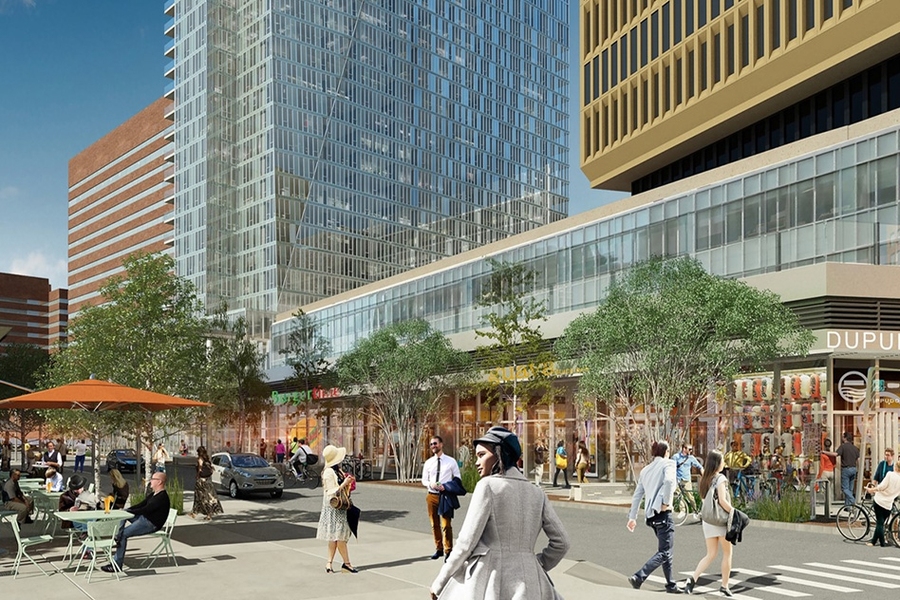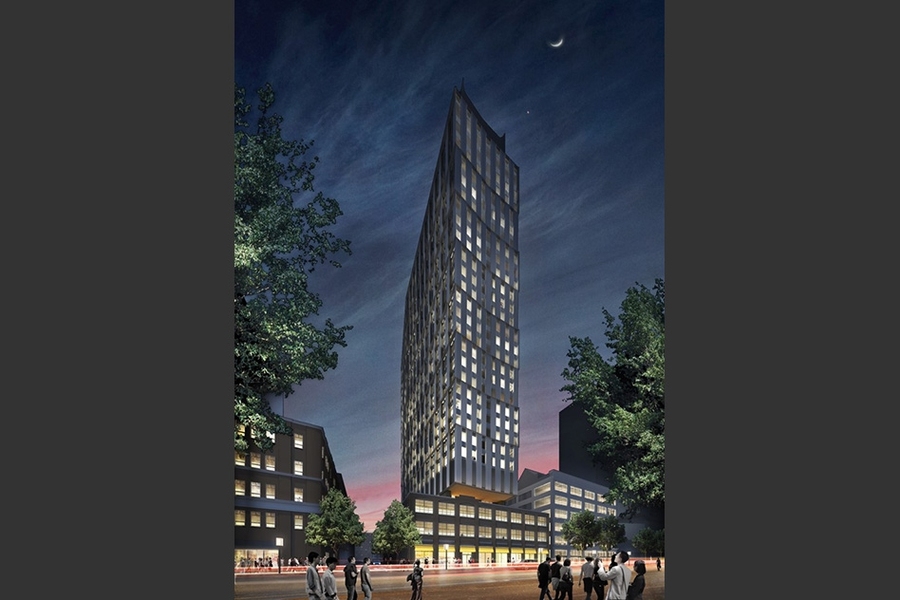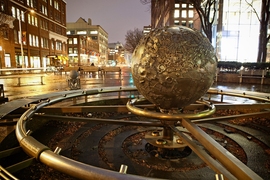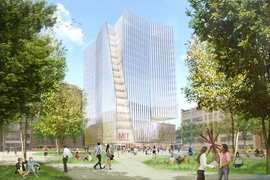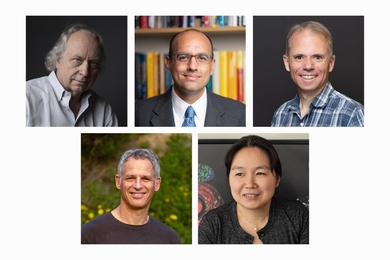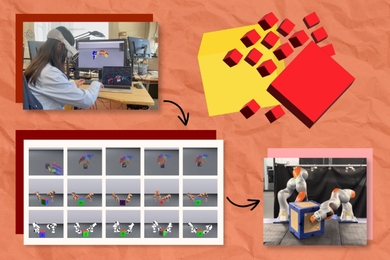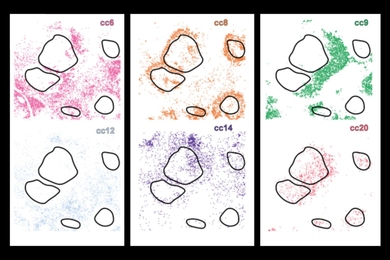In response to a broad range of questions and suggestions raised at the Institute’s Sept. 8, 2015, City of Cambridge Planning Board hearing, MIT returned to the board on Jan. 5 to provide an updated presentation for its proposed Kendall Square Initiative.
In its presentation, MIT described changes in the development plan that addressed specific Planning Board concerns related to building designs, façade treatments, and the positioning of retail space, and also answered questions related to the integration of historical structures, the use of cantilevers, the public realm experience, housing, sustainability, pedestrian and bicycle amenities, parking, and vehicular access.
In the months following the September Planning Board meeting when the Institute received a unanimous preliminary development approval, MIT met frequently with city staff regarding every aspect of the proposed development. This dialogue led to MIT’s submission of a final development plan and special permit application to the city in November for two planned unit developments — “NoMa” (north of Main Street) and “SoMa” (south of Main Street). In addition, formal input from several city departments and committees related to the proposal was submitted to the Planning Board for its consideration.
The Kendall Square Initiative aims to create a vibrant mixed-use district featuring six new buildings on what are now MIT-owned parking lots in the East Campus/Kendall Square area, including three buildings for research and development, two for housing, and one for retail and office space. The plan will produce approximately 250 net new housing units for graduate students and approximately 290 new housing units for market use, more than 100,000 square feet of new and repositioned ground-floor retail, and nearly three acres of new and repurposed open spaces — in addition to providing research and development space in support of Kendall Square’s growing innovation district.
The Initiative was developed as a result of approximately seven years of internal and external dialogue. The Cambridge City Council approved new zoning for MIT’s properties in the East Campus/Kendall Square area in 2013, laying the foundation for the advancement of the mixed-use proposal.
The Jan. 5 presentation was led by Marty Schmidt, MIT’s provost; Hashim Sarkis, dean of the School of Architecture and Planning and professor of architecture; Karen Gleason, associate provost and the Alexander and I. Michael Kasser Professor of Chemical Engineering; and Steve Marsh, managing director of real estate in MIT’s Investment Management Company, in addition to the architects who are designing each of the buildings and the landscape architect who is designing the open space.
Provost Marty Schmidt opened the SoMa presentation by describing the comprehensive effort involved in examining MIT’s East Campus area: “This was an incredible process with many stakeholders. We were presented with a unique opportunity to expand our residential community, infuse new vibrancy into Kendall Square with retail and public gathering spaces, create space for innovative research and development activities, introduce a new gateway to MIT, and create a vibrant crossroads that will connect us more closely to the Cambridge community.” Schmidt thanked Sarkis and faculty from the School of Architecture and Planning for their steady leadership and guidance during the process.
Associate Provost Karen Gleason reflected on the introduction of new graduate student housing in the heart of Kendall Square: “Graduate students are the engine of MIT. It’s critical that they are an integral component of the Kendall Square ecosystem.”
In providing an overview to the design approaches for the six buildings, Sarkis described how the process is guided by “a collective vision that encourages individuality.” He cited five main strategies that were developed organically among the architects: to create buildings that have clearly defined bases, middles, and tops; to preserve and enhance the existing historical buildings; to differentiate the building masses further with horizontal and vertical breaks; to create a variety of façade types using different approaches to sustainability; and to design an array of outdoor spaces that will facilitate pedestrian flow and a strong public realm. Sarkis praised the architectural teams, noting their “robust professionalism and creativity.”
Steve Marsh closed MIT’s presentation by thanking city staff and Planning Board members for their dedicated work alongside MIT: “We are creating an exciting place where MIT, the residential community, and businesses can gather, socialize, and collaborate.”
After the presentation, several members of the public offered comments and observations related to a variety of topics, including pedestrian and bicycle connections; the nature of retail; wayfinding; the interface with historical structures; graduate student housing; MBTA service; parking; open space; shadow and lighting impacts; and building design.
Planning Board members expressed appreciation for the hard work on the part of MIT and City of Cambridge staff, and shared thoughts regarding the complexity of city-making, the importance of civic “spaces for all,” the art of placemaking, the need for careful consideration in order to achieve authenticity in Kendall Square, the balancing of architectural diversity and coherence, and the creation of programmatic elements that are uniquely MIT.
Follow-up questions were raised by Planning Board members regarding open-space design and programming; wind and shadow impacts; vehicular access; the exploration of alternative and green facades; the nature of the extension of the Infinite Corridor; graduate student housing; the placement of the MBTA headhouse; bicycle facilities; loading operations; the accommodation of museum visitors; the flood plain district; parking; mechanical equipment; and construction phasing.
In considering MIT’s fulfillment of the planned unit development requirements, Planning Board member Hugh Russell quipped about the contemporary and varying styles of the proposed building designs: “MIT has done everything that we’ve asked them to do and they’ve surprised us. Well, we may just have to step up to the plate and be surprised.”
At the close of the nearly five-hour hearing, Planning Board Chair Ted Cohen observed: “It is a very exciting proposal and there is a tremendous amount that is excellent in it. We are getting close to what we need to approve the planned unit development.”
The Planning Board’s public hearing process will continue over the coming months. The next hearing will focus on details related to the public realm including retail, open space, and ground floor design. Once the next hearing date is established, it will be posted on the Kendall Square Initiative website. As always, questions, comments, and ideas about the development proposal can be sent to kendallsquare@mit.edu.
